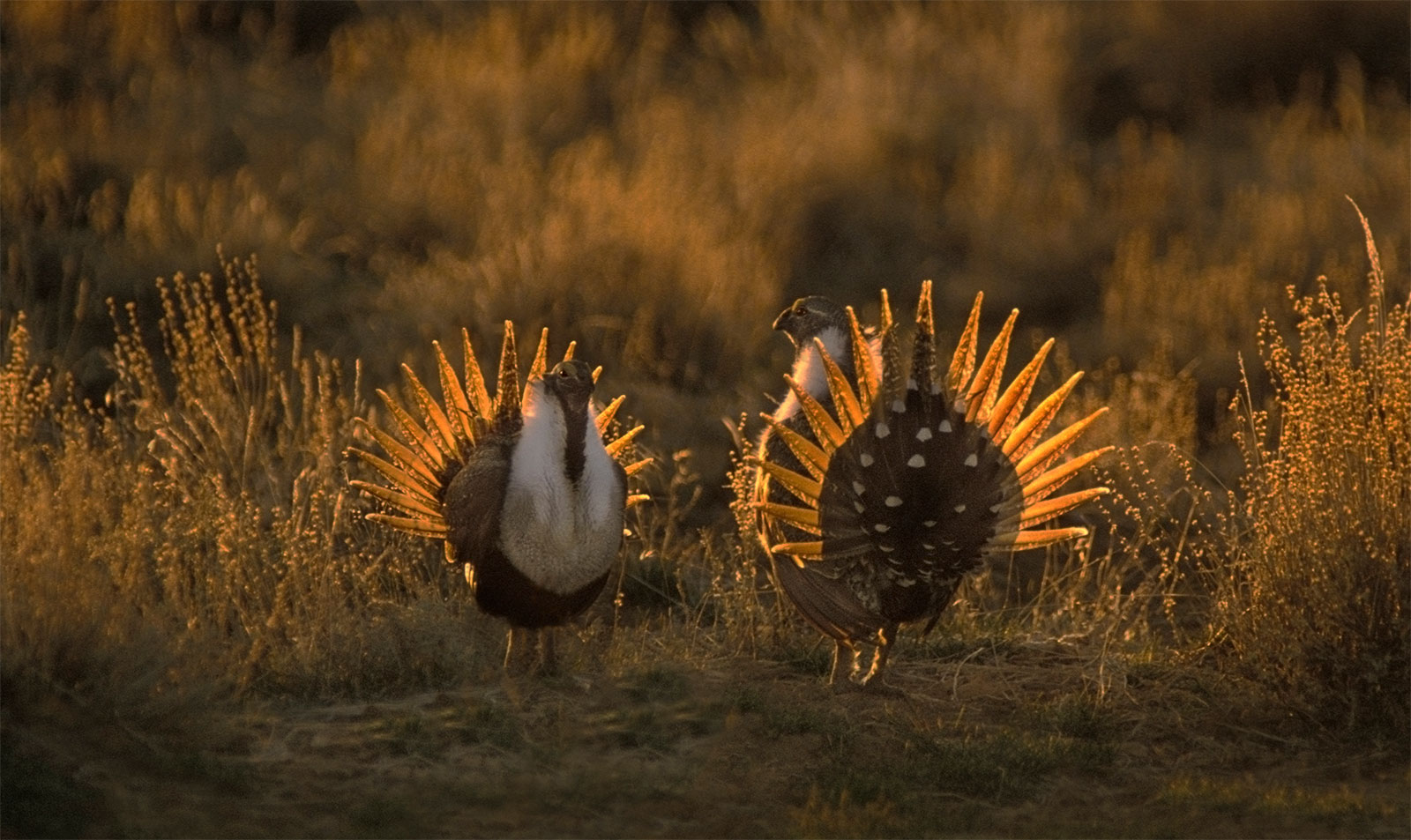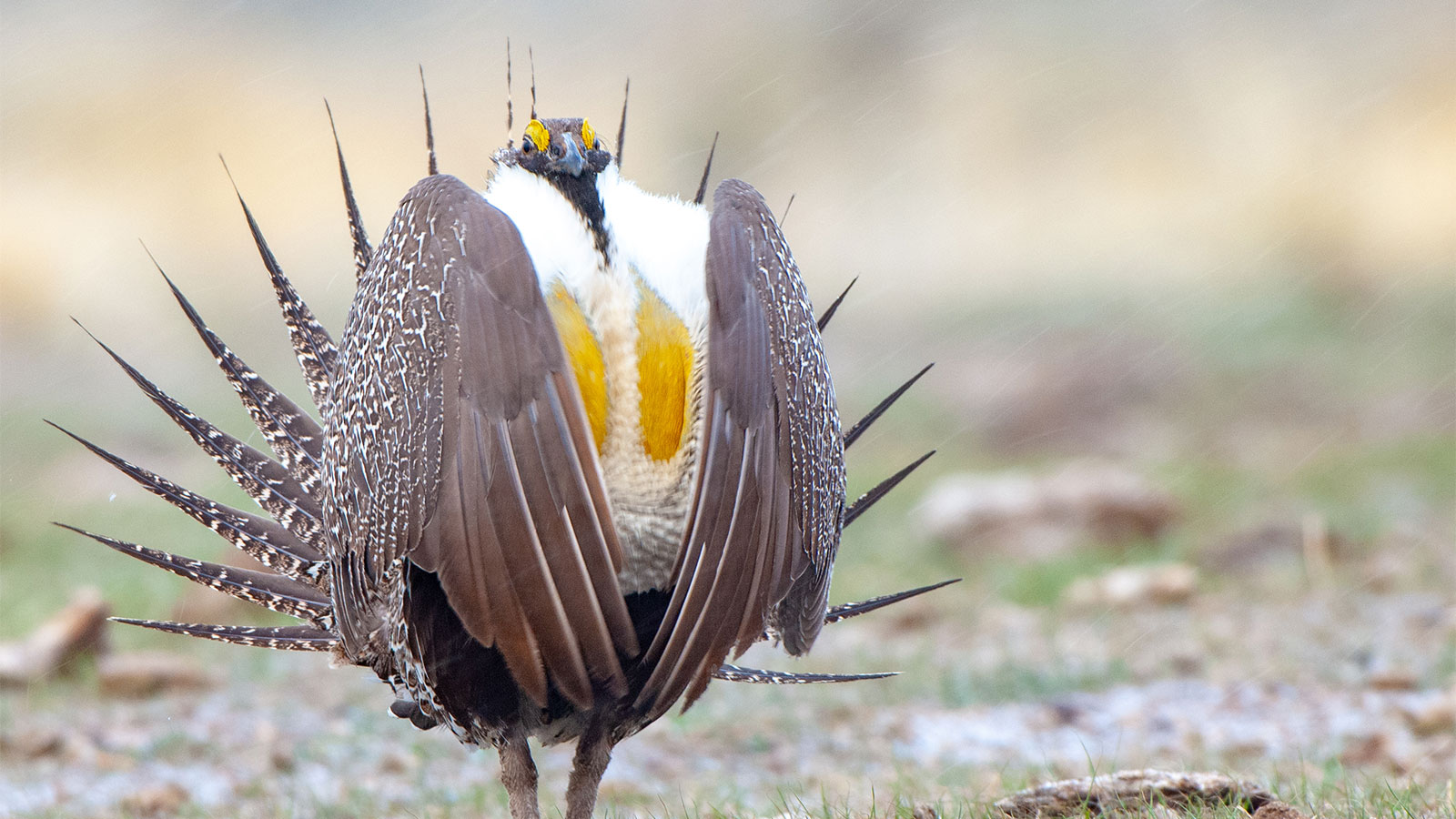To combat the biodiversity crisis, the Sierra Club supports establishing a national goal to conserve at least 30 percent of U.S. land, and 30 percent of U.S. ocean areas by 2030. Known as the 30×30 Agenda, this campaign has the potential to not only benefit wildlife, but improve outdoor equity and expand representation of historically marginalized groups on public lands. This three-part series explores the potential implications of such measures from locations across the country.
The sage grouse mating ritual is like no other. A male bird pops its chest out to reveal two yellow sacs filled with air. As they bounce, the sacs generate a noise like a rubber ball on pavement. It’s often referred to as the ‘dance’ of the sage grouse, and the bird with the best choreography wins a mate.
But the sage grouse and its iconic dance have long been under attack. Settlers who colonized land in the west in the 1800s introduced invasive species that destroy habitat and food sources the bird needs. More recently, human activity like oil and gas leasing, improper livestock grazing, and other development has reduced its habitat further. Once found in 13 states, the bird is now extinct in half of its historic range.
Most of the sage grouse population now relies on public lands—but not all public lands are protected equally. Millions of acres are in fact used by extractive industries, like drilling for oil. Private development has significantly impacted the integrity of what’s often referred to as the ‘sagebrush sea.’ Experts say that a renewed focus on the protection and conservation of public lands can safeguard the vast and complex ecosystem and its many native species, like the sage grouse.
“We’re facing a crisis moment for sage grouse, where federal agencies, states, private landowners [and] public users all need to pitch in to conserve sagebrush habitat—or we could end up losing this species across large areas of its range,” says Mark Salvo, program director of the Oregon Natural Desert Association.
Sage grouse require vast amounts of uninterrupted land to mate, raise fledglings, and mature. Each new oil and gas lease is a threat. Human activity at well sites and the vehicle traffic along roads to get there are “substantial enough to drive sage grouse away … so 100% of the [surrounding] habitat is lost,” says Eric Molvar, the executive director of Western Watersheds Project.
This habitat fragmentation leads the birds to search for new undisrupted space, interrupting their tradition of returning to the same areas to mate each year—causing population numbers to spiral downward.
There are several ways the Bureau of Land Management, the federal agency that manages much of the country’s sagebrush habitat, could protect the sage grouse. Most importantly, the agency could permanently conserve public lands. They could also work with Native Tribes to establish land stewardship partnerships based on Indigenous traditional ecological knowledge. In 2018, a federal court found that Endangered Species Act protections had been wrongfully denied to the bird, and the US Fish and Wildlife Service was required to re-evaluate the sage grouses’ status. The bird was subsequently proposed for protection, but the Trump administration blocked the proposal in March of 2020. These protections, including designation of critical habitat, are needed to keep the grouse from a continued slide into extinction.

Molvar explains that a coalition led by the environmental non-profit Defenders of Wildlife recently put a proposal to do just that in front of the Bureau of Land Management and the Forest Service, which together manage 78 of the 150 million acres of sagebrush habitat. The proposal suggests setting aside areas of critical environmental concern, and applying stronger protections in sage grouse habitat. Molvar says that to meet the Biden administration’s biodiversity goals, the agencies need to protect these ecologically valuable landscapes. “Will the agencies have the backbone to do it?” he asks. “That remains to be seen.”
Since the introduction of cheatgrass by settlers in the 1800s, the sagebrush sea has been increasingly taken over by the invasive, non-native plant. It destroys the habitats that protect sage grouse from predation, and reduces the diversity of the understory that helps maintain soil moisture. And cheatgrass burns. Along with improper grazing and longer drought seasons, the spread of cheatgrass has primed the landscape for wildfire. Unlike native grasses, which are fire resistant, cheatgrass also sequesters less carbon. This is especially devastating for sagebrush — which accounts for the vast majority of the sage grouse diet — because it can’t resprout after fire, often needing to reestablish from seed.
Conservation of what’s left of the sagebrush sea wouldn’t just benefit the sage grouse. The bird requires a broad range of environmental conditions to thrive, which means that protecting the sage grouse safeguards many other species, like elk, deer, and antelope. Ecologists also rely on sage grouse population numbers to determine the health of other animal and plant species. “We need strong, bold action that commits to conservation and commits to initiatives like the 30×30 Agenda in a whole, full-throated way,” Molvar said.
Other interventions include addressing destructive practices with a long-term plan, says Mary Pendergast, an ecologist and conservation biologist with the Sageland Collaborative. To do so requires everyone to have a seat at the table — ranchers, conservationists, citizen scientists, and federal representatives.
She explains that conservation priorities need to balance the business needs of ranchers and the ecological needs of the sagebrush sea. “If you’re not taking those long- term approaches, then you’re not necessarily going to be doing what’s best for the native biodiversity or for having forage for cattle,” Pendergast said. She believes in working with ranchers to implement science-based solutions, which she hopes can meet both needs.
“It really is all hands on deck,” she says.
Scientists say we need to safeguard 30 percent of America’s land by 2030 to avoid mass extinction and climate catastrophe. The U.S. ranks as one of the top countries in the world when it comes to wilderness-quality land. Right now, roughly 12 percent of that is protected land—and the Sierra Club has played a role in saving nearly all of it. That means we have to protect more lands in the next decade than we did in the last century. With an ambitious agenda and strong local advocacy, we can still conserve much of these natural areas. Every acre counts.

